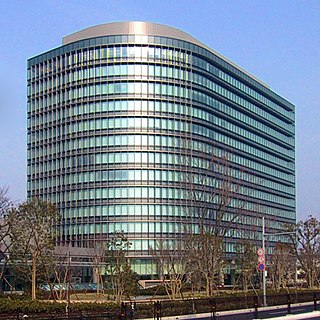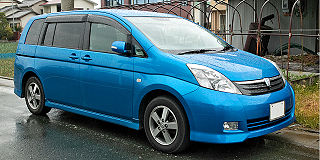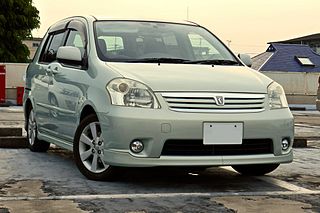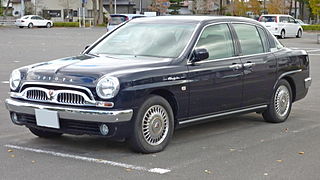
The Toyota Motor Corporation is a Japanese multinational automotive manufacturer headquartered in Toyota, Aichi, Japan. It was founded by Kiichiro Toyoda and incorporated on August 28, 1937. In 2017, Toyota's corporate structure consisted of 364,445 employees worldwide and, as of December 2019, was the tenth-largest company in the world by revenue. Toyota is the largest automobile manufacturer in the world followed by Volkswagen, based on 2020 unit sales. Toyota was the world's first automobile manufacturer to produce more than 10 million vehicles per year, which it has done since 2012, when it also reported the production of its 200 millionth vehicle. As of July 2014, Toyota was the largest listed company in Japan by market capitalization and by revenue.
Toyota Central R&D Labs., Inc. (TCRDL) is the arch institute of the Toyota Group. It cooperates with Toyota Group and Toyota Technological Institute (TTI). The facility is located in Nagakute, near Nagoya in Aichi, Japan. The facility was established in November 1960 with a capital of 500 million Yen. Currently, there are about 1000 employees conducting both fundamental and applied research in a large variety of topics for the Toyota group and other partners. The current president is Ishikawa, and the current capital is 3 billion yen.
The Toyota Group is a group of companies that have supplier, vendor and investment relationships with Toyota Industries and Toyota Motor vehicle manufacturing facilities. It is similar to a keiretsu in that no particular entity has outright control over the entire group, although unlike most keiretsu it does not contain a major bank. It started with the loom manufacturing company Toyota Industries.

The Toyota Comfort, released on December 19, 1995, was designed for use as a taxicab in Japan. A long-wheelbase version, called Toyota Crown Comfort is available in Japan, Hong Kong and Singapore.

The Toyota Ist is a subcompact car manufactured by the Japanese automaker Toyota. It is exported to the United States as the Scion xA and Scion xD, the Middle East as the Toyota xA and to Europe and Latin America as the Toyota Urban Cruiser for the second generation.
The WiLL brand was a marketing approach shared by a small group of Japanese companies who decided to offer products and services that focused on a younger demographic from August 1999 until July 2004 in Japan. The companies that participated were the Kao Corporation, Toyota, Asahi Breweries, Panasonic, Kinki Nippon Tourist Company, Ltd, Ezaki Glico Candy, and Kokuyo Co., Ltd.. Toyota also engaged in a similar "youth oriented" approach in North America, with the Project Genesis program. This selective marketing experiment reflected a Japanese engineering philosophy called Kansei engineering, which was used by other Japanese companies. All products were listed online at "willshop.com".

The Toyota Isis is a seven-seat large MPV manufactured by Kanto Auto Works under contract for Japanese automaker Toyota. It is sold in Japan and was launched in September 2004. It features sliding doors and is available with either front- or four-wheel drive and straight-4 1.8- and 2.0-litre gasoline engines. It competes in Japan with the Honda Stream and the Nissan Lafesta.

The Toyota Raum is 5-seat mini MPV that first appeared in May 1997. The second generation was released in May 2003. It was sold only in Japan at Toyota Netz retail sales channels.

The Toyota Corolla Verso is a compact MPV first released by Toyota in January 1997, until production of the third generation ceased in March 2009 and production of its replacement, the Verso, began.

The Toyota Ractis is a mini MPV produced by Japanese automaker Toyota. It is a five-seater mini MPV based on the Vitz, and was introduced in October 2005 as the successor of the Yaris Verso/Fun Cargo. The name "Ractis" is derived from "Run", "Activity" and "Space".

The Toyota Origin is a limited edition mid-size car made by Toyota and released in Japan between 2000 and 2001. It was made available for sale in November 2000. It was planned that only 1,000 units of the car would be available, but in fact, 1,073 units were produced. In Japan, it was sold at Toyota Store, Toyopet Store and Corolla Store Japanese dealerships.
Central Motor Co., Ltd. was a Japanese manufacturer of cars within the Toyota Group. It was founded on 4 September 1950 by Ryuichi Tomiya. The company operated five plants, all located in Japan. It was one of the biggest export vehicle manufacturers of the concern. In July 2012 it was merged with two other Toyota subsidiaries operating in Tohoku to form Toyota Motor East Japan.

The automotive industry in Japan is one of the most prominent and largest industries in the world. Japan has been in the top three of the countries with most cars manufactured since the 1960s, surpassing Germany. The automotive industry in Japan rapidly increased from the 1970s to the 1990s and in the 1980s and 1990s, overtook the U.S. as the production leader with up to 13 million cars per year manufactured and significant exports. After massive ramp-up by China in the 2000s and fluctuating U.S. output, Japan is currently the third largest automotive producer in the world with an annual production of 9.9 million automobiles in 2012. Japanese investments helped grow the auto industry in many countries throughout the last few decades.
Kanto Auto Works (関東自動車工業) was a Japanese car manufacturer. It was a member of the Toyota Group. In July 2012, Kanto Auto Works and two other Toyota subsidiaries were merged to form Toyota Motor East Japan.

The Toyopet Master, introduced in January 1955, is a passenger car that was an evolution of the earlier Toyota SF/RH sedan with a modernized body. As with its predecessor, the Master has a ladder frame truck chassis with leaf sprung solid axles both at the front and the rear. The more conservative Master was sold in parallel with the first Toyota Crown as a frugally equipped and robust version meant for taxi usage. The Master and Crown shared the same R-series engine, which produces 48 PS (35 kW) in the Master. It was sold at a chain of Toyota Japan dealerships called Toyota Store, next to the more upscale Crown, which was intended as a private purchase alternative to the Master.
Toyota Motor East Japan is a manufacturing subsidiary of the Toyota group based in Japan. It was founded in July 2012 by the merger of Kanto Auto Works Ltd, Central Motor Co. Ltd and Toyota Motor Tohoku Corporation.
Toyota Auto Body is a manufacturing subsidiary of the Toyota group based in Japan. It is headquartered in Kariya, Aichi and was established in 1945. The company has plants in the Mie and Aichi prefectures and other facilities around Japan and abroad.

The automotive industry in the Philippines is the 9th largest in the Asia-Pacific region, with approximately 273.4 thousand vehicles sold in 2019. Most of the vehicles sold and built in the Philippines are from foreign brands, for the most part, the Philippines is dominated by Japanese automobile manufacturers like most of its ASEAN neighbors. The automobile production in the country is covered under the Philippine Motor Vehicle Development Program being implemented by the Board of Investments. In addition, there are also a small number of independent firms who assemble and fabricate jeepneys and other similar vehicles, using surplus engines and drivetrain parts mostly from Japan.
Toyota Motor Kyushu (TMK) is a manufacturing subsidiary of Toyota established in 1991 and focused on the production of Lexus cars, engines, and hybrid systems. Its headquarters and single assembly plant are in Miyawaka, Fukuoka. Car production started in December 1992.










